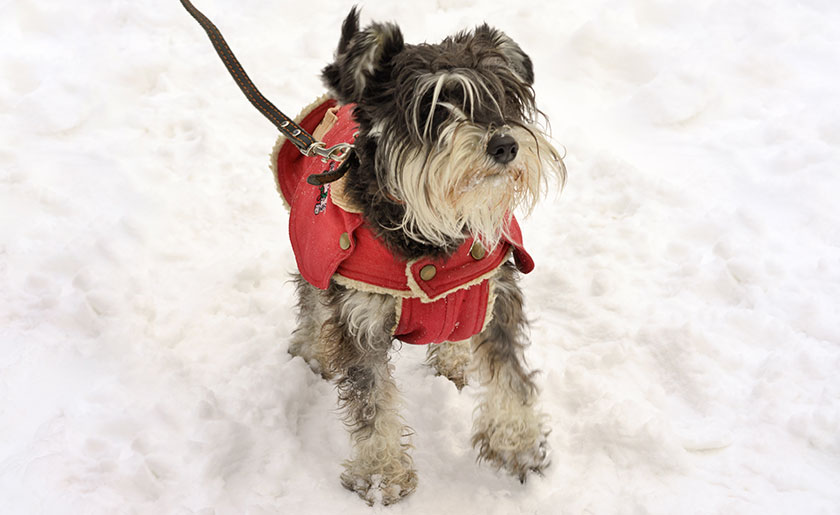We live in a country of extremes. There’s snow and ice at one end and bone-melting heat at the other. It’s your job to make sure your best pal can cope, whatever the weather.
Rugging Up
Nippy out? Your dog will be feeling it too. Here’s our checklist to make sure he’s toasty:
- Second helpings: Any dog that’s too thin will feel the cold more. Dogs that spend more time outdoors, or those that are very active might need a bit more food in the winter months.
- Extra layers: If your dog is more of a lounge lizard and especially if he’s older, ill or short-haired, he might benefit from a dog jacket for outside activities.
- Comfy quarters: If he’s sleeping outdoors, he’ll need a warm, secure pad, off the ground, free of draughts and leaks and insulated. Make sure it’s not too big, because his body heat won’t be enough to warm it up. Indoor dogs also need a warm spot out of any cold currents.
- Wipe his feet: If ice and snow are left on your dog’s paws, the moisture can cause sores. Always wipe thoroughly after a wintry frolic, including in between the toes and the footpads.
- Beware the antifreeze: If it’s needed in your home, make sure it’s kept well away from curious snouts and tongues. The sweet taste is extremely appealing and it can be fatal.
- Frozen water: Ensure your dog’s water supply is not frozen.
- Frostbite do’s and don’ts: DO take him straight to the vet if you suspect frostbite. DON’T rub the frozen tissue. This can potentially cause more damage.
Behavioural Tip from Dr Jo
- Dogs like to be near us when they sleep. Consider bringing them indoors in extreme weather conditions, perhaps into the laundry or kitchen area, if you don’t want them in your bedroom.
- If your dog has a kennel but refuses to sleep in it, try putting it close to the backdoor of your home or under your bedroom window. Also put a few treats inside it to encourage your dog to enter.
The Heat is On
It’s harder for a dog to stay cool, because they don’t sweat like we do. Some breeds suffer worse than others. Here’s how to prevent any emergencies when the mercury rises.
- Wet wet wet: Free access to fresh, cool water is a must for any dog, but even more so in summer. Have 2 or more water bowls available in case of extreme thirst, or if your dog knocks one over.
- Road trip rules: Heading off on holiday? Don’t forget to take along plenty of H20 and a wet towel (or even a spray bottle), which can be a quick way to help him cool off. Plus, remember that a car can heat up pretty quick. Never leave your friend in the car – it can be a death sentence.
- Chill out: Love to go for a run with your mate? You still can – just choose cooler times of the day, like early morning or late evening.
- Blisters in the sun: We remember to slap on the sunscreen, but some of us forget our dogs can be just as vulnerable to sunburns and skin cancer. Special dog sunscreen (never use the human kind) is available, and of course, the best preventative of all – staying indoors, or in the shade.
- Not panting, boiling: Heat stress can come on quickly if your dog is exposed to high temperatures, humidity and poor ventilation. Older dogs, those with flat faces, overweight dogs and puppies and dogs unused to hot weather are especially at risk. Look for panting, a staring or worried facial expression, failure to respond to commands, warm, dry skin, a high temperature, dehydration, rapid heartbeat and collapse. Get to a vet ASAP.
- Sweaty paws: Dogs can sweat through their foot pads so you may notice wet paw prints if you pooch is feeling the heat.
- Festival fun: Big outdoor fun can be kind of overwhelming for your four-legged friends. Think twice before you extend the invitation. How noisy or busy will it be? How easy will it be to give your dog a drink or food? How crowded will it be? Will there be a lot of other dogs there too?
- It’s a breeze: Providing your dog with a fan on a hot day can help bring relief – just make sure this is a supervised cool down to avoid any fan-related accidents!
Dr Lisa says..
- Dogs can become stressed in extreme weather conditions
- Outdoor dogs may need extra food in winter and shade in summer
- Dogs may become heat-stressed very quickly
- Fresh water is vital any time of the year
- Never leave your dog in the car
Dr Jo says..
- Extra care is required for senior, ill or overweight dogs and puppies, as well as those with flat faces
- Make sure wherever they’re sleeping is warm, dry and free of draughts
Did you know?
One study reports that when the outside temperature is 26ºC, the inside of a car will reach 32ºC in five minutes and 43ºC in 25 minutes.
Getting help
Dogs feel the weather, sometimes more than we do. Being responsive to their needs is part of our job as canine companions. If you think your dog is stressed from the cold or the heat, do what you can to relieve his discomfort.
Top tip:
Watch that hot footpath! It can burn your dog’s pawpads.



0 Comments